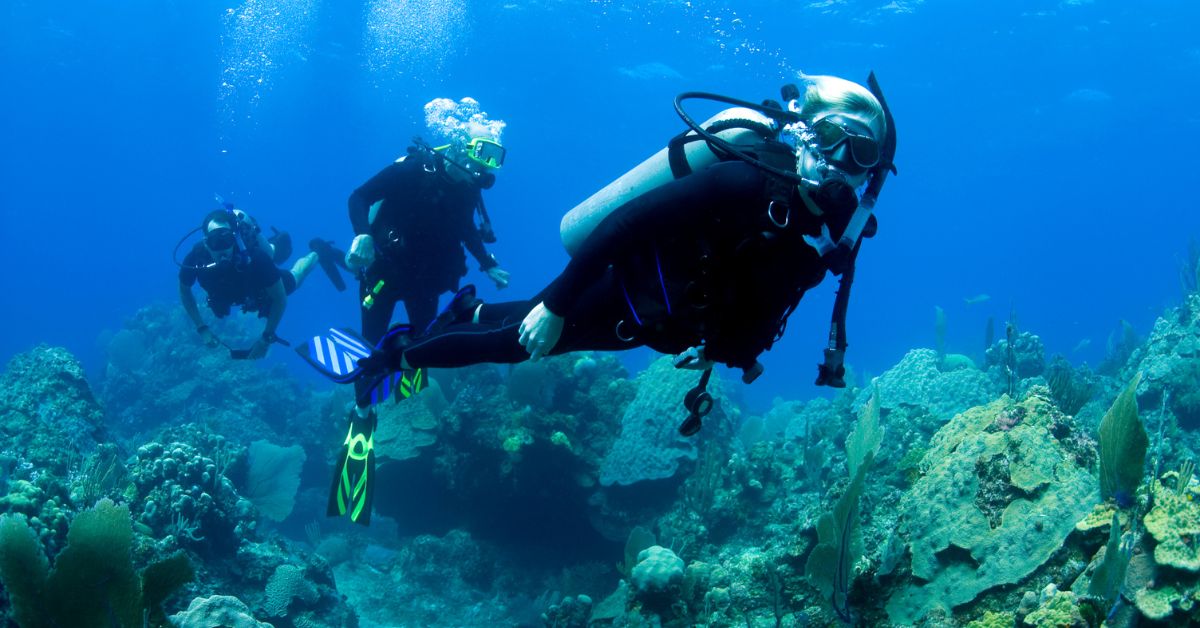Unlock the Secrets to Mastering Air Consumption for Longer Dives
If you’ve ever found yourself surfacing sooner than planned due to air limitations, you’re not alone. Learning to master air consumption for longer dives is a game-changer for divers seeking extended bottom time and enhanced experiences underwater. This guide dives deep into techniques to improve air consumption diving, conserve air while diving, and adopt efficient practices to optimize air use underwater.
By implementing these strategies, you’ll not only enjoy more time exploring the underwater world but also reduce stress, conserve energy, and become a more confident diver.
Why Air Consumption Matters in Scuba Diving
Air consumption determines how long you can stay underwater and explore the marine environment. By managing your air effectively, you can enjoy longer, more immersive adventures and fully take in the wonders of the ocean without the pressure of cutting your dive short prematurely.
Enhancing Buoyancy and Control Underwater
Efficient air usage directly impacts your ability to maintain proper buoyancy, which is essential for smooth and controlled dives. Good buoyancy lets you move effortlessly through the water, reducing exertion and allowing you to conserve energy while focusing on the beauty of the underwater world.
Reducing Fatigue and Conserving Energy
Improved air consumption helps reduce physical strain and fatigue during your dive. When your breathing is efficient and you’re not overexerting yourself, your body has more energy to spare. This is especially critical during multiple dives, ensuring that every descent remains as enjoyable and comfortable as the first.
Prioritizing Safety Through Better Air Management
Proper air consumption contributes significantly to dive safety. By conserving air, you reduce the likelihood of needing to rush your ascent or encountering stress due to a low air supply. This helps ensure a calm, controlled dive experience and allows for safer ascents, minimizing the risk of decompression-related issues.
Transforming Your Diving Experience
Mastering air consumption elevates every aspect of your dive. It enhances your freedom to fully engage with your surroundings, from exploring vibrant coral reefs to observing marine life up close. By focusing on efficient breathing techniques and mindful diving, you can turn each dive into a longer, more fulfilling journey into the underwater world.
Breathing Techniques for Divers: The Foundation of Efficiency
Mastering air consumption for longer dives starts with learning how to breathe efficiently, but that’s only part of the equation. Combining proper breathing techniques with other strategies, like slowing your movements and mastering water currents, will not only help you conserve air but also make your dives smoother and more enjoyable.
Slow, Deep Breathing for Relaxation and Efficiency
To master air consumption for longer dives., slow, deep breaths are crucial. Shallow, rapid breathing wastes air and increases CO2 in your system, which can leave you feeling out of breath. Instead, focus on diaphragmatic breathing to maximize your lung capacity, allowing your body to absorb more oxygen with each breath. This reduces the number of breaths you need, helping to optimize air use underwater.
Slow Your Movements to Save Air
One of the easiest ways to conserve air while diving is to slow down. Many divers waste air by swimming too quickly or making unnecessary movements. Fast, erratic motions increase resistance in the water, forcing your body to work harder and use more air. By moving at a steady, deliberate pace, you can reduce drag and conserve energy, which directly translates to improved air efficiency.
Practice Slow and Efficient Finning Techniques
Finning efficiently is another important strategy to reduce air usage scuba diving. Proper finning not only helps you conserve energy but also reduces strain on your body. Instead of kicking rapidly, practice slow and controlled kicks with your fins, focusing on a full range of motion. Frog kicks and modified flutter kicks are particularly effective for conserving energy and air. Avoiding unnecessary movements, like frequent adjustments or sculling with your hands, can further help you maintain a relaxed, efficient posture.
Mastering Diving in Water Currents
Water currents can be one of the most challenging factors affecting air consumption. Fighting against a strong current significantly increases physical exertion and air usage. Instead of swimming directly against the current, use strategies to work with it. Begin your dive heading into the current so that you can enjoy an easier return when your air supply is lower. Position yourself close to the reef or bottom to find areas where the current is weaker. Streamline your body by tucking in your arms and ensuring your gear is secured to reduce drag. These techniques not only help conserve air but also make the dive far more enjoyable.
Relax and Stay Present Underwater
Relaxation is a cornerstone of efficient diving. Stress or anxiety often leads to rapid breathing and unnecessary movements, which waste air. Before your dive, take a moment to calm your mind and focus on your breathing. During the dive, stay aware of your surroundings and adopt a mindful approach to your movements and breathing. A relaxed diver is a more efficient diver, capable of extending bottom time and fully appreciating the underwater world.
Combining Strategies for Peak Efficiency
The key to master air consumption for longer dives is combining effective breathing techniques with strategies like slowing your movements, refining your finning technique, and working with the current. These skills complement one another, allowing you to conserve energy and extend your dive time significantly. As you practice and refine these techniques, you’ll find yourself not only diving longer but also feeling more confident and at ease underwater.
By integrating these strategies, you’ll unlock the ability to enjoy longer dives, explore further, and truly make the most of your underwater adventures. Whether you’re a beginner or a seasoned diver, adopting these practices will transform the way you approach air consumption and elevate your diving experience.
Plan Efficiently: Increase Dive Time Strategies
Mastering air consumption for longer dives isn’t just about what happens underwater—it starts with proper dive planning. A well-thought-out dive plan can help you conserve air, stay relaxed, and extend your time exploring the underwater world. By combining strategic preparation with efficient techniques, you can make the most of every dive while improving your overall scuba diving air consumption.
Stay Within Your Limits
The first rule of efficient diving is to operate within your limits. Pushing yourself into conditions beyond your skill level, such as strong currents, low visibility, or deep dives, often leads to stress and increased exertion. Stress impacts your breathing, causing you to use air faster than necessary. Stick to dive sites and profiles that match your experience and comfort level. Gradually build your skills and confidence so you can tackle more challenging dives without compromising your ability to optimize air use underwater.
Practice Pre-Dive Breathing Exercises
Efficient breathing begins before you even enter the water. Taking time to relax and practice deep breathing before your dive can significantly improve your air efficiency underwater. Pre-dive breathing exercises help lower your heart rate, reduce anxiety, and prime your body for a calm and controlled dive. Try slow, diaphragmatic breathing to prepare your lungs for optimal oxygen exchange and to set the tone for your dive. This simple habit is an effective way to conserve air while diving and increase your bottom time.
Choose Appropriate Dive Profiles
Selecting dive profiles that align with your skill level and fitness can greatly impact your ability to reduce air usage scuba diving. For instance, starting with shallower dives allows you to use less air due to the reduced pressure at shallower depths. Plan your dives to include plenty of time for exploration without rushing or overexerting yourself. Profiles that involve gradual descents, limited swim-throughs, and minimal current will allow you to dive comfortably while maintaining better air efficiency.
Account for Environmental Factors
Environmental conditions play a significant role in air consumption. Strong currents, colder water, and rough surface conditions can all increase your exertion, causing you to use more air. When planning a dive, research the site’s conditions and time your dive during calmer periods, such as slack tide. If you’re diving in colder waters, ensure you’re wearing adequate thermal protection, as the cold can increase your breathing rate and reduce your ability to extend bottom time diving.
Streamline Your Dive Plan
Efficient dive planning also includes thinking about your route and activities underwater. Plan a streamlined dive that minimizes unnecessary swimming or backtracking. Use natural navigation cues like reef contours and landmarks to conserve energy and avoid prolonged exertion. By eliminating wasted motion and maintaining a steady, deliberate pace, you’ll be able to focus on enjoying the dive while conserving air.
Incorporate Buddy Communication and Roles
Diving with a buddy is not just about safety; it can also help improve your air efficiency. Discuss your dive plan in detail with your buddy before entering the water. Assign roles, such as navigation or monitoring depth and time, to ensure a smooth, coordinated dive. Clear communication underwater reduces stress and confusion, helping both you and your buddy optimize air use underwater.
Gradually Improve Fitness Levels
Your physical fitness plays a significant role in how efficiently you consume air. Improved cardiovascular fitness and core strength help you move more efficiently underwater, reducing air consumption and fatigue. Activities such as swimming, yoga, and strength training can build your stamina and lung capacity, enhancing your ability to increase dive time strategies. Incorporating these into your routine will pay dividends in your diving performance.
Monitor Air and Stay Aware
One of the simplest yet most effective aspects of dive planning is consistently monitoring your air supply and depth throughout the dive. By keeping track of your air usage, you can adjust your pace and movements to conserve energy. Staying aware of your consumption rate will allow you to plan your ascent without rushing, reducing the chances of running low on air. This habit is essential for improving your scuba diving air consumption and making the most of your dive.
The Impact of Efficient Dive Planning
When you plan your dive with air efficiency in mind, you set yourself up for a longer, safer, and more enjoyable underwater experience. By staying within your limits, practicing pre-dive breathing exercises, and tailoring your dive profile to the conditions, you can significantly enhance your ability to master air consumption for longer dives. Combine these strategies with mindful underwater practices, and you’ll discover how to unlock the full potential of every dive.
Real-Life Testimonials: How Divers Improved Their Air Consumption
“After focusing on my buoyancy and practicing deep breathing, I managed to extend my dive time by 15 minutes. It transformed my underwater adventures! I feel more relaxed and can truly enjoy the underwater scenery without worrying about my air supply.” — Sarah, Advanced Diver
“I never realized how much gear streamlining mattered until I tightened everything up. By reducing drag and keeping my gear secured, I noticed an immediate difference—longer dives and a more enjoyable experience. It’s incredible how small changes make such a big impact.” — Samira, Divemaster Trainee
“Practicing slow, controlled finning techniques completely changed my air consumption. Once I adopted the frog kick and slowed my pace, I found I could conserve so much energy and extend my dive time significantly. Plus, it’s less stressful on my legs!” — Hiroshi, Rescue Diver
“Learning how to work with the current instead of fighting it made a huge difference for me. My instructor taught me how to use natural contours and stay streamlined, and my air efficiency improved overnight. I can enjoy current dives now without feeling exhausted!” — Emily, Open Water Diver
“Pre-dive breathing exercises have been a game-changer. I used to feel anxious before diving, which affected my air consumption. After learning relaxation and breathing techniques during my Advanced Open Water course, I’m more confident, calmer, and I can dive longer.” — Ryan, Advanced Diver
The Science Behind Breathing Techniques Underwater
To master air consumption for longer dives, it’s crucial to understand the physiological processes behind breathing underwater. Your body reacts differently in the unique environment of increased pressure, and mastering breathing techniques can significantly improve your air efficiency. By diving into the science, we can better appreciate why proper breathing is the cornerstone of longer, more comfortable dives.
How Pressure Impacts Breathing Underwater
As you descend, the pressure around you increases, causing the air you breathe from your tank to compress. This means you consume more air per breath at greater depths, making efficient breathing essential for conserving your air supply. Studies on respiratory physiology in divers have shown that slow, deep breathing reduces the frequency of inhalations, allowing you to minimize air usage and maintain a calm state throughout the dive.
Oxygen and Carbon Dioxide Exchange
The process of oxygen exchange is fundamental to controlling air consumption. Your lungs absorb oxygen while removing carbon dioxide (CO2) from your bloodstream. If CO2 builds up—often caused by shallow or rapid breathing—it triggers the urge to breathe more frequently. Controlled diaphragmatic breathing enhances the efficiency of this exchange, enabling you to maintain a balanced breathing rhythm. Research on gas exchange in divers highlights how deeper breaths optimize this process, helping you conserve air and focus on extending your dive time.
The Role of Diaphragmatic Breathing
Diaphragmatic breathing, or belly breathing, is a proven technique for optimizing oxygen use. This method ensures that your lungs fully expand, improving oxygen absorption while keeping your heart rate low. A relaxed, slower heart rate means less energy expenditure, which directly impacts your ability to master air consumption for longer dives. Many diving experts and training programs emphasize this technique because of its profound effects on dive efficiency and relaxation.
Stress Reduction Through Breathing
Stress and anxiety are common factors that increase air consumption. When a diver feels stressed, their body instinctively reacts with rapid, shallow breathing, which wastes air. Research in sports physiology and mindfulness training demonstrates that controlled breathing calms the nervous system, reducing stress and improving performance. Divers who practice these techniques can better manage challenging conditions, such as strong currents or low visibility, while maintaining a steady breathing rhythm.
Mastering Air Consumption for Longer Dives
To truly master air consumption for longer dives, understanding the science of breathing underwater is essential. From managing the effects of pressure to optimizing oxygen exchange and staying relaxed, breathing techniques play a vital role in improving air efficiency. By applying these principles, divers can enhance their performance, reduce fatigue, and enjoy the underwater world for extended periods. For further insights, consider exploring materials on diving physiology, such as studies on oxygen efficiency and stress management in scuba diving, often included in advanced diving courses or research by organizations like DAN (Divers Alert Network).
Enhance Your Skills with PADI Courses
To truly master air consumption for longer dives, consider enrolling in PADI courses designed to refine your skills and boost your confidence underwater. Courses like the PADI Advanced Open Water Diver, Peak Performance Buoyancy, and Enriched Air Nitrox teach essential techniques to conserve air, optimize your dive time, and navigate challenging conditions. These courses are led by experienced instructors who will help you develop the skills to become a more efficient and confident diver.
Conclusion: Dive Longer, Dive Smarter
Improving your air consumption isn’t just about staying underwater longer—it’s about diving smarter, safer, and with greater confidence. By focusing on strategies like mastering buoyancy, streamlining your gear, perfecting your finning techniques, and working with currents, you can truly master air consumption for longer dives. These techniques don’t just extend your bottom time; they also allow you to enjoy the underwater world more comfortably and efficiently. Many divers, like those in the testimonials above, have found that refining these skills opens up new possibilities, making every dive more rewarding.
Ready to take the next step in your diving journey? Whether you’re aiming to master air consumption for longer dives, gain new certifications, or enhance your skills, we’re here to help you achieve your goals. Contact us today to book your next dive, explore our courses, or discover how to optimize air use underwater and transform your underwater adventures. Let’s dive deeper together!


